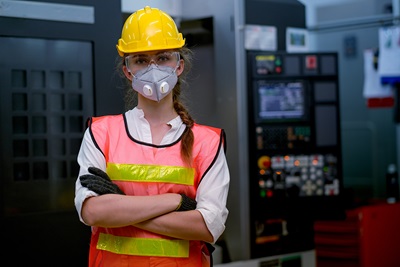As companies begin bringing employees back to the workplace, providing a safe and healthy environment is their primary focus. As important as testing and entry protocols are, preparing the workplace for safe return of employees is likely the best way to limit the risk of virus transmission at the worksite.
Physical Distancing
CDC guidelines suggest that “limiting face-to-face contact with others is the best way to reduce the spread of coronavirus disease 2019.” According to the Centers for Disease Control and Prevention (CDC) and the World Health Organization, the best way to avoid transmission of the virus is to implement physical distancing guidelines. Industry type and job role will impact the ability of an employee to effectively do their job while physically distant from co-workers, but there are common strategies that many employers are implementing and should be considered as they bring their workforce on-site:
Importance of Collaboration Across Your Company
Some large employers have created a COVID-19 response task force within their organizations that includes leaders from multiple teams within their organizations. Many of the decisions made by these groups may be implemented by facilities teams, informed by the expertise of leaders within the HR, occupational health, legal, security and other teams.
- Only bring a segment of your employees back to the worksite at a time and stagger or alternate when groups of employees are on the worksite. If possible, employers should consider bringing only a subset of the workforce back at a given time. This will allow them to seat employees in workstations further apart from each other as compared to a full worksite. See Who Should Return to the Worksite and When? for more information.
- Place workstations at least 6 feet apart.
- Put markers on the floor that show 6-foot distances between people to create norms for physical distancing in locations where people would normally be in close proximity. This could be in the entry way to a building, at any line that a customer may wait in, inside an elevator to show how many people should be in at a given time and in the cafeteria
- Where possible, “direct people traffic” by using signage and floor markings to encourage people to move in a single direction in a small space to reduce the likelihood of face-to-face interactions.
- Reduce or eliminate in-person meetings, where possible. In-person meetings should be held in rooms where it is possible to keep participants at least 6 feet from each other. This may require some workers to participate remotely.
Common rooms:
- Any common room that is open should be cleaned often. The CDC has guidelines for cleaning materials necessary to disinfect surfaces.
- Encourage employees to arrive to their shift right as they begin, rather than arriving early and mingling with co-workers in common areas.
- In cafeterias, seating should be reduced to give visual cues about sitting apart from co-workers while eating. Eliminate buffets, which experts posit may be one of the riskiest actions one could take related to virus exposure. Indoor eating around others outside of your household also greatly increases your risk, so many employers have kept cafeterias closed, just as many governments have prohibited restaurant seating indoors. Consider providing prepackaged, boxed meals with disposable cutlery that employees can take to eat away from others or outside on breaks.
- For gyms and fitness centers, create an online sign-up system where workers can sign up to use it at particular intervals to limit the number of people t at the gym at a given time. Gyms are particularly high risk given heavy breathing and close proximity, so many employers have kept them closed. Encouraging people to take walks outside rather than go to the gym or even creating an outside workout space are alternative ways to encourage physical activity while limiting the risk of exposure.
- Nursing mothers should continue to be encourage to do so, as breast milk has a low chance of risk of transmission of COVID-19 to babies, according to limited data available as of July 2020. Still, according to the CDC, there is a lot we don’t know, and all precautions should be taken to ensure that breastfeeding devices and surfaces, as well as the woman’s body, is kept clean prior to and after pumping. Nursing rooms should be cleaned in between each usage, and sign-ups may again be appropriate to limit traffic in and out of these rooms.
Stay Six Feet Apart, Unless You’re on the Metric System
References in this section to staying six feet away from others is certainly a U.S.-centric framing. Employers operating outside of the U.S. should take care to adhere to country-specific guidance on distance requirements, which may be more stringent and are almost certain, of course, to use the metric system.
- In well-being and nursing rooms, be aware that soft surfaces, like couches, may require different cleaning techniques to be kept sanitized and to avoid damaging the material. Frequently cleanings may also be necessary. For these reasons, employers may want to replace soft-surface furniture with plastic or metal alternatives that are more durable and can better withstand frequent cleaning. In addition, consider creating plexiglass barriers between seating areas to allow for more people to use common rooms without increasing the risk of infection.
The Ultimate Physically Distanced Work: Teleworking
A few companies have already decided to allow employees who are currently working from home to continue to do so for the foreseeable future, even as they open up their worksites. Some employers report that their workforce that can operate remotely are even more productive at home, though burnout is a concern going forward. In at least one country – Singapore – employees in roles that can be performed remotely must do so, or else their companies are subject to a penalty. See Who Should Return to the Worksite and When? for more information.
Create Barriers to Prevent Transmission
In worksites where it is not possible to keep employees at least 6 feet away from each other, employers need to create barriers between employees and customers, where applicable. Physical barriers range from the basics--a face mask or face shield (see PPE section below)--to more complicated re-engineering of production lines to allow for physical barriers or distancing between workers who had previously been in close proximity to each other.
Physical barriers can include:
- Sneeze guards between workers who operate in close proximity by necessity with other workers or customers.
- A reduction in the number of customers in a confined space (e.g., limiting the percentage of tables that are open in a restaurant, reducing travelers on planes or trains, etc.).
- Cubicles with higher walls or offices with closed doors.
Personal Protective Equipment (PPE)
The acronym “PPE” has unfortunately become a household term in the past few months, as people have come to understand the positive impact that face masks can have in reducing transmission of COVID-19. While some employees may be required to use medical-grade PPE to safely perform their jobs, for the vast majority of employees, non-medical PPE is recommended to preserve medical-grade PPE for those who need it.

The amount of non-medical PPE required for employees returning to work cannot be underestimated. With many locations having legally mandated that individuals wear face coverings in public or enclosed areas, many employees may be required to wear one when returning to the worksite. In addition, if screenings such as temperature checks are to occur on-site, people administering those screenings need to have extensive PPE, such as face guards or full body coverings.
Employers report that sourcing PPE for employees conducting screenings has been a challenge. As the internal staff conducting screenings are often the priority, it may be difficult to obtain supplies for the entire workforce. Nonetheless, many companies provide PPE for employees who do not have shields, work on assembly lines or have jobs that require two people working in close proximity. Some companies are providing cloth face coverings that employees need to launder and bring back each day. Other companies with manufacturing capabilities have also reengineered their production lines to produce masks in order to deal with the shortage for their companies and others across the country.
Be Clear with Employees About Expectations for PPE on the Job
Guidance about mask usage has varied over time, and as it has evolved, so have government policies. For example, the Singapore government has made it mandatory for all persons (including essential employees at the workplace) to wear a mask when leaving their home, while still encouraging people to stay home as much as possible. In China, masks are also required when riding the company transportation shuttle; in fact, a well-controlled worksite that may not require employees to use PPE on the job may still require them to wear PPE to and from work. The CDC in the United States recently recommended that the American public wear cloth masks when around others but avoid using medical-grade masks in order to save them for health care workers. While non-medical grade masks have not been shown to be 100% effective in preventing individuals from contracting the virus, given the evidence about asymptomatic transmission, masks may help prevent infection from someone who is an asymptomatic carrier. In this changing environment, employers will need to communicate regularly and effectively, as guidelines are continuing to change (see Section Five: Communications for more ideas on how to create a culture of caring within the workplace to increase a sense of collective health and adherence to PPE usage and other protocols for reducing the spread of COVID-19).
Office Cleaning and Personal Hygiene
COVID-19 is principally transmitted through the air, but it can remain active on surfaces that are touched by multiple people. Workplaces should be regularly sanitized; at least daily, if not more often, depending on turnover of workplace shifts, visitors or customers. Other cleaning considerations include:
- Having hand sanitizing stations in multiple locations around the worksite. This has been standard practice in medical settings for years; even many grocery store entrances have had them available for years l. It’s a simple step, but one that can make hand cleanliness easier and normalized.
- In addition to hand sanitizing stations, signage and communication from managers should encourage regular handwashing.
- Common areas, like bathrooms, elevators, staircases, cafeterias, gyms, on-site clinics or other gathering areas, should be cleaned frequently, if they are opened at all.

Wash your hands.
Hand washing with standard soap is more effective than hand sanitizers in destroying the virus and protecting transmission from hands to the eyes, nose or mouth.

Wear a face covering.
The CDC suggests that masks are a key part of preventing the spread of the virus. Several studies now suggest that covering your face dramatically reduces the likelihood that you contract or transmit the virus.

Watch your distance.
COVID-19 spreads through aerosols (aka, the air) and on commonly touched surfaces. By staying 6 feet or more from others, when possible, one can dramatically reduce the likelihood of infection.
Airflow
Evidence suggests that COVID-19 transmission risk is reduced when people are outside, as particulates in the air dissipate more quickly. While indoors, air should be filtered.
- Consider how bathrooms are set up in your worksite. Flushing a toilet or urinal creates airflow in a confined area that may push COVID-19 cells into the air. Install lids and touchless flush systems for both. For the same reason, hand dryers that blow air may be less safe than paper towels.
- According to the Environmental Protection Agency, portable air cleaners can help reduce the potential for transmission of COVID indoors.
- Where it is safe and feasible, open windows.
Move Work Outside to Reduce Risk and Improve Mental Health
“Getting some fresh air” is perhaps a cliched term, but there are clear physical and mental health benefits to being outside, when whether allows. Restaurants opening in many areas of the country are utilizing outside seating to reduce the likelihood of transmission that comes with gathering indoors. Office workers with laptops and Wi-Fi or smartphones can often work outside when the weather allows, including for physically distanced meetings.
Elevators and Staircases
Elevators and stairwells do not allow for physical distancing, at least as traditionally used. When using either, masks should be required of employees.
- Elevators: Employers should allow only as many people as can stand 6 feet apart, which can be visually aided by markers on the floor. Although this will increase the time it takes for people to move around an office building it is much safer. Markers should also be placed on the floor for people to wait for the elevator in a physically distanced line.
- Stairwells: If your office has two stairwells, consider having one be an “up” staircase and the other a “down” staircase. This strategy will eliminate the possibility that people will face each other as they pass each other.
Acknowledging Limitations
As of July 2020, several countries, including the U.S., Germany, and China, are seeing increases in COVID-19 infections after previous successes in flattening the curve of cases. An ideal worksite setup could dramatically decrease the risk of COVID-19 spread while people are at work, but it does not prevent employees from getting infected outside the workplace. Barring CDC laboratory-level, full body protective equipment, procedures and an effective vaccine, there will be no worksite that is “perfectly” ready to prevent worksite transmission of disease or address the challenge of community spread.
Therefore, returning employees to the worksite requires careful planning and a strategy that takes into account the risks and benefits to employees and their families. At the same time, employers need to manage the business reality of continuing to operate while also being in compliance with government requirements. There are few easy answers. Fortunately, two of the most effective strategies for reducing the risk of spread in the worksite – handwashing and face coverings – are inexpensive and relatively easy to implement.
Reduce the Risk of Transmission by Making Common Areas “Touchless”
Elevators, doors to stairwells and entryways can be made touchless with key fobs or automatic doors. The classic water cooler can be replaced by bottled water or removed altogether. Objects that have to be touched by multiple people, like a fridge, should have a hand sanitizer station next to it.
More Topics
Articles & Guides-
IntroductionReturn-to-Workplace Employer Guide
-
Part 1Return-to-Workplace: Who Should Return to the Workplace and When?
-
Part 2Return-to-Workplace: Entry Screening Requirements: Symptom Checkers and Temperature Checks
-
Part 3Return-to-Workplace: Employer Strategy: To Test or Not to Test
-
Part 4Return-to-Workplace: Workplace Readiness
-
Part 5Return-to-Workplace: Employee Communications Strategies and Lessons Learned
This content is for members only. Already a member?
Login
![]()
